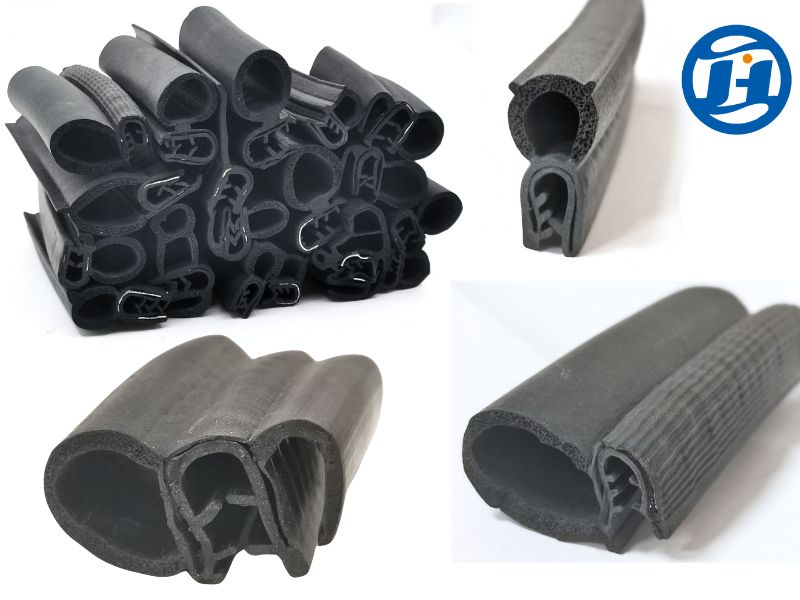What Are You Looking For?

Rubber extrusion strips are an essential component in a variety of industrial sectors, offering a range of benefits in terms of performance, durability, and versatility. These strips are formed through the process of rubber extrusion, where rubber compounds are heated and forced through a die to create continuous shapes with consistent cross-sections. Due to their unique properties, rubber extrusion strips are widely used across industries such as automotive, construction, manufacturing, and more. This article explores the importance of rubber extrusion strips in industrial applications, their characteristics, and the key factors that influence their performance.
Rubber extrusion strips are long, continuous lengths of rubber material formed into various shapes and profiles to meet specific industrial requirements. These strips can be designed with a wide range of cross-sectional geometries, from simple flat strips to more complex profiles such as seals, gaskets, or weatherstripping. The extrusion process allows manufacturers to produce rubber strips in bulk with high precision, enabling large-scale production for industrial use.
Customizable Shapes and Sizes: One of the primary advantages of rubber extrusion is the ability to create custom profiles that meet specific application needs. Manufacturers can adjust the size, shape, and hardness of the rubber strips to ensure compatibility with different equipment, machinery, or environments. This makes rubber extrusion strips suitable for a variety of industries with diverse requirements.
Durability and Longevity: Rubber extrusion strips are highly durable, offering resistance to wear, tear, and harsh environmental conditions. They are resistant to abrasion, temperature fluctuations, UV radiation, ozone, and many chemicals. As a result, rubber extrusion strips can withstand the demands of both indoor and outdoor applications, extending their lifespan and reducing maintenance costs.
Sealing and Insulation Properties: Many rubber extrusion strips are designed to serve as seals or gaskets. These strips can prevent the ingress of dust, moisture, air, or chemicals, making them essential for maintaining the integrity of machines and systems. Their excellent sealing properties make them ideal for use in doors, windows, engines, or pipelines, ensuring energy efficiency and preventing contamination.
Noise and Vibration Dampening: Rubber is an excellent material for dampening noise and vibration, making it valuable in industrial applications where reducing sound or vibration is crucial. Rubber extrusion strips are often used in machinery, automotive components, or construction to minimize operational noise and enhance comfort and safety.
Versatility: Rubber extrusion strips can be produced using various rubber compounds, such as EPDM (Ethylene Propylene Diene Monomer), silicone, nitrile, neoprene, and more. This versatility enables the production of strips with specific properties, such as resistance to heat, oil, water, or ozone, depending on the requirements of the application.
Automotive Industry: In the automotive sector, rubber extrusion strips are used for a wide range of applications, including door seals, window gaskets, and weatherstripping. These components ensure a tight seal against water, dust, and noise, contributing to the overall performance, safety, and comfort of vehicles. Additionally, rubber strips are used in vibration isolation for components like engines and suspension systems.
Construction and Building: Rubber extrusion strips are extensively used in construction for sealing windows, doors, roofs, and floors. They are also applied in expansion joints, providing flexibility and preventing structural damage caused by temperature fluctuations and settling. In addition, rubber strips are used for soundproofing and thermal insulation in commercial and residential buildings.
Manufacturing and Machinery: Rubber extrusion strips play a crucial role in the manufacturing and machinery sectors. They are used as seals and gaskets in machinery to prevent leaks, reduce energy loss, and protect sensitive equipment from dust, dirt, and moisture. In some cases, they are used as protective covers or edge guards to prevent damage to products or equipment during production or transport.
Food and Beverage Industry: In food processing and packaging, rubber extrusion strips are often used as seals for containers, machinery, and processing equipment. The materials used in these applications must meet stringent hygiene standards, and rubber strips provide a reliable, flexible solution for maintaining cleanliness and preventing contamination.
Electrical and Electronics Industry: Rubber extrusion strips are used in electrical and electronics manufacturing to protect wires and cables from damage, prevent moisture ingress, and offer electrical insulation. Their flexibility and resistance to environmental factors make them ideal for safeguarding delicate components in harsh industrial environments.
Material Selection: The performance of rubber extrusion strips is heavily influenced by the type of rubber material chosen. For instance, EPDM is known for its excellent resistance to UV light, ozone, and weathering, making it ideal for outdoor applications. Silicone rubber is commonly used in high-temperature environments, while nitrile rubber is preferred for applications involving oil and fuel resistance.
Temperature Range: The temperature stability of rubber materials is a key factor to consider when selecting extrusion strips for industrial applications. The material should be able to withstand the operating temperature range without degrading or losing its sealing properties.
Compression and Hardness: The hardness of the rubber material affects its ability to maintain a seal under compression. A material that is too soft may compress too easily and fail to provide an effective seal, while one that is too hard may not compress sufficiently to create a tight fit.
Environmental Exposure: The level of exposure to various environmental factors, such as UV radiation, chemicals, moisture, and ozone, will impact the longevity and effectiveness of rubber extrusion strips. Choosing the right material and coating (if necessary) is crucial for ensuring optimal performance.
Rubber extrusion strips are indispensable in a wide range of industrial applications due to their customizable shapes, durability, sealing properties, and versatility. From automotive to construction, food processing, and beyond, these strips offer reliable solutions for ensuring efficiency, safety, and performance. As industries continue to evolve and demand more specialized solutions, the role of rubber extrusion strips in modern manufacturing processes will remain crucial, providing essential functions that enhance the functionality and longevity of equipment and systems.